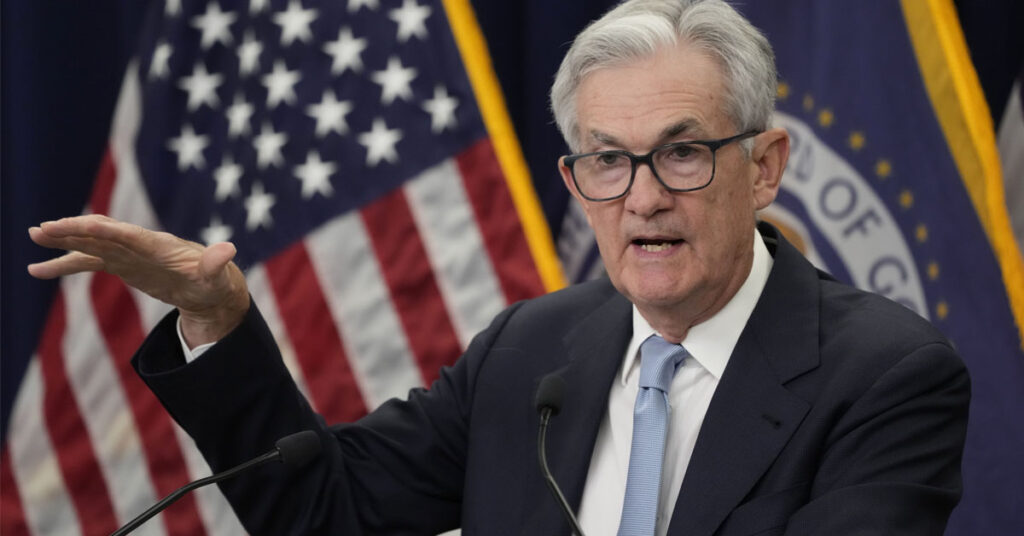As widely expected, the Federal Reserve decided to keep interest rate hikes unchanged on Wednesday, marking a second straight meeting in which the central bank elected to forgo a rate hike.
The move (or lack thereof) keeps the target range for the Fed’s benchmark rate at 5.25% to 5.50%. The rate remains at its highest level in more than two decades, but the decision to extend the pause nonetheless triggers a sigh of relief from the still-flagging mortgage and real estate industries, which have seen home sales decimated by the high interest rate environment.
Last month, Lawrence Yun, chief economist for the National Association of Realtors, said that “the Federal Reserve simply cannot keep raising interest rates in light of softening inflation and weakening job gains,” citing existing home sales that had plunged to their lowest levels in 13 years.
All 12 members of the Fed’s policy-setting Federal Open Market Committee (FOMC) voted to hold interest rates steady.
A consensus among observers has been that the Fed will continue to sit back and monitor the impacts of its proactive monetary policy as it ripples through the economy, which has remained remarkably resilient despite the Fed raising interest rates 11 times since March 2022. Consumer spending has persistently outperformed expectations, ending the third quarter with an 0.7% surge in September, while real gross domestic product grew at an outsized annual rate of 4.9% from July through September.
In its newest statement, the Fed acknowledged that the economy is still exceeding expectations, comments that were similar to the ones released after the FOMC meeting in September. One of the few changes the Fed made in the statement was to upgrade its verbiage from “solid” to “strong” when referring to third-quarter economic activity.
Federal Reserve Chair Jerome Powell nodded to still-strong economic conditions in his post-meeting press conference. He also pointed out areas of progress for the economic tempering needed to bring inflation back to the Fed’s 2% target range. Nominal wage growth has shown some signs of easing, Powell noted, while hiring has declined “somewhat” and has helped lead to favorable inflation readings since the summer.
But “a few months of good data are only the beginning,” he said. Powell described inflationary pressures as “well anchored,” and he matter-of-factly added that “the process of getting inflation sustainably down to 2% has a long way to go.”
Core inflation, according to the U.S. Department of Labor Statistics, currently stands at 4.1% annually, a substantial decrease from its 6.6% peak last year but still well short of the Fed’s 2% target.
As he has during the past few post-meeting press conferences, Powell was swift to note the hardships imposed by the Fed’s aggressive interest rate policy on consumers’ wallets, as well as to rate-sensitive sectors like real estate. But he repeatedly went back to the familiar refrain of the second prong of the Fed’s dual mandate: price stability.
“In light of the uncertainties and risks, and how far we have come, the committee is proceeding carefully,” Powell said. “We will continue to make our decisions meeting by meeting based on the totality of the incoming data, and their implications for the outlook and for economic activity and inflation, as well as the balance of risks.”
He stressed that the FOMC hasn’t yet made any interest rate decisions for its December meeting, nor is it currently considering lowering rates.
Reacting to the Fed’s decision, Marty Green, principal at Texas mortgage law firm Polunsky Beitel Green, likened the central bank to “a blackjack player with two face cards.”
“The only sensible play at this meeting was to hold pat,” Green said. “Since the last meeting, the markets have basically done the Fed’s work for them, with the rise in rates for Treasurys and mortgages equating to another interest rate increase. The lag effect of the Fed’s policy decision was on full display, with the economy continuing to absorb the full impact of the Fed’s decisions from earlier in the year, even with the Fed taking no additional action.”
Green believes it’s “increasingly clear that the Fed is indeed done raising rates in this cycle.” Asked before the FOMC meeting whether he sees another rate increase in the pipeline, he reiterated that market forces are already doing the Fed’s work for them.
“I think they’re actually at their terminal rate already,” Green said. “I don’t think they’re going to raise rates any further. One of the reasons they’re able to probably do that is mortgage rates and other rates have been elevated. That makes it less necessary for them to raise rates to get them a little higher.
“At this point, if you really look at it, the Fed raising rates another quarter of a point is not going to matter much at the end of the day. I think they want the market to think they’re prepared to raise them additionally if they need to, but I don’t see them doing it.”








